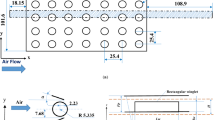Abstract
Convective heat transfer enhancement can be achieved by generating secondary flow structures that are added to the main flow to intensify the fluid exchange between hot and cold regions. One method involves the use of vortex generators to produce streamwise and transverse vortices superimposed to the main flow. This study presents numerical computation results of laminar convection heat transfer in a rectangular channel whose bottom wall is equipped with one row of rectangular wing vortex generators. The governing equations are solved using finite volume method by considering steady state, laminar regime and incompressible flow. Three-dimensional numerical simulations are performed to study the effect of the angle of attack α of the wing on heat transfer and pressure drop. Different values are taken into consideration within the range 0° < α < 30°. For all of these geometrical configurations the Reynolds number is maintained to Re = 456. To assess the effect of the angle of attack on the heat transfer enhancement, Nusselt number and the friction factor are studied on both local and global perspectives. Also, the location of the generated vortices within the channel is studied, as well as their effect on the heat transfer enhancement throughout the channel for all α values. Based on both local and global analysis, our results show that the angle of attack α has a direct impact on the heat transfer enhancement. By increasing its value, it leads to better enhancement until an optimal value is reached, beyond which the thermal performances decrease.
















Similar content being viewed by others
References
Khoshvaght-Aliabadi M, Zangouei S, Hormozi F (2015) Performance of a plate-fin heat exchanger with vortex-generator channels: 3D-CFD simulation and experimental validation. Int J Therm Sci 88:180–192
Hachem F, Khaled M, Ramadan M, Habchi C (2014) Boundary Layer Development on a Concave Surface: Flow Visualization and Hot Wire Velocity Measurements. J Energy Power Eng 8:1177–1182
Alahyari Beig S, Mirzakhalili E, Kowsari F (2011) Investigation of optimal position of a vortex generator in a blocked channel for heat transfer enhancement of electronic chips. Int J Heat Mass Transf 54:4317–4324
Jiang Y, Zheng Q, Dong P, Zhang H, Yu F (2014) Research on heavy-duty gas turbine vane high efficiency cooling performance considering coolant phase transfer. Appl Therm Eng 73:1175–1191
Basu DN, Bhattacharyya S, Das PK (2014) A review of modern advances in analyses and applications of single-phase natural circulation loop in nuclear thermal hydraulics. Nucl Eng Des 280:326–348
Fiebig M (1998) Vortices, Generators and Heat Transfer. Chem Eng Res Des 76:108–123
Habchi C, Russeil S, Bougeard D, Harion JL, Lemenand T, Della Valle D, Peerhossaini H (2012) Enhancing heat transfer in vortex generator-type multifunctional heat exchangers. Appl Therm Eng 38:14–25
Anxionnaz Z, Cabassud M, Gourdon C, Tochon P (2008) Heat exchanger/reactors (HEX reactors): Concepts, technologies: State-of-the-art. Chem Eng Process Process Intensif 47:2029–2050
Ghanem A, Habchi C, Lemenand T, Della Valle D, Peerhossaini H (2013) Energy efficiency in process industry – High-efficiency vortex (HEV) multifunctional heat exchanger. Renew Energy 56:96–104
Tiggelbeck S, Mitra NK, Fiebig M (1992) Flow Structure and Heat Transfer in a Channel with Multiple Longitudinal Vortex Generators. Exp Thermal Fluid Sci 5:425–436
Jacobi AM, Shah RK (1995) Heat Transfer Surface Enhancement through the Use of Longitudinal Vortices: A Review of Recent Progress. Exp Thermal Fluid Sci 11:295–309
Habchi C, Lemenand T, Della Valle D, Pacheco L, Le Corre O, Peerhossaini H (2011) Entropy production and field synergy principle in turbulent vortical flows. Int J Therm Sci 50:2365–2376
Mohand Kaci H, Habchi C, Lemenand T, Della Valle D, Peerhossaini H (2010) Flow structure and heat transfer induced by embedded vorticity. Int J Heat Mass Transf 53:3575–3584
Zhou G, Feng Z (2014) Experimental investigations of heat transfer enhancement by plane and curved winglet type vortex generators with punched holes. Int J Therm Sci 78:26–35
Wang CC, Chen KY, Lin YT (2015) Investigation of the semi-dimple vortex generator applicable to fin-and-tube heat exchangers. Appl Therm Eng 88:192–197
Fiebig M (1995) Embedded Vortices in Internal Flow: Heat Transfer and Pressure Loss Enhancement. Int J Heat Fluid Flow 16:376–388
Fiebig P, Kallweit N, Mitra S (1991) Tiggelbeck, Heat Transfer enhancment and drag by longitudinal vortex generators in channel flow. Exp Thermal Fluid Sci 4(1):103–114
Wu JM, Tao WQ (2008) Numerical study on laminar convection heat transfer in a channel with longitudinal vortex generator. Part B: Parametric study of major influence factors. Int J Heat Mass Transf 51:3683–3692
Wu JM, Tao WQ (2008) Numerical study on laminar convection heat transfer in a rectangular channel with longitudinal vortex generator. Part A: Verification of field synergy principle. Int J Heat Mass Transf 51:1179–1191
Tiggelbeck S, Mitra NK, Fiebig M (1994) Comparison of wing-type vortex generators for heat transfer enhancement in channel flows. J Heat Transf 116:880–885
CD-adapco, STAR CCM+, Version 8, Users Manual. http://www.cd-adapco.com/products/star-ccm/documentation
Celik IB, Ghia U, Roache PJ, Freitas CJ, Coleman H, Raad PE (2008) Procedure for Estimation and Reporting of Uncertainty Due to Discretization in CFD Applications. J Fluids Eng 130:078001–078001
Bejan A, Kraus A (2003) Heat Transfer Handbook, vol 1. Wiley, New Jersey, pp 395–438
Author information
Authors and Affiliations
Corresponding author
Ethics declarations
Conflict of interest
On behalf of all authors, the corresponding author states that there is no conflict of interest.
Charbel Habchi (May 10, 2017).
Rights and permissions
About this article
Cite this article
Khanjian, A., Habchi, C., Russeil, S. et al. Effect of the angle of attack of a rectangular wing on the heat transfer enhancement in channel flow at low Reynolds number. Heat Mass Transfer 54, 1441–1452 (2018). https://doi.org/10.1007/s00231-017-2244-8
Received:
Accepted:
Published:
Issue Date:
DOI: https://doi.org/10.1007/s00231-017-2244-8



